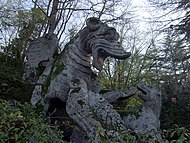To the Future
| To the Future | |
|---|---|
| Dutch:Naar de toekomst | |
 | |
| Artist | Carel Willink |
| Year | 1965 |
| Medium | Oil on canvas |
| Dimensions | 109 cm × 150 cm (43 in × 59 in) |
| Location | Museum MORE,Gorssel,the Netherlands |
To the Future(Dutch:Naar de toekomst) is a painting made by the DutchmanCarel Willinkin 1965. It shows two sculptures from theGarden of Bomarzoand a man in anasbestos suitwho walks toward a large explosion. It belongs to a group of late Willink paintings that portrayapocalypticconfrontations between modern technology and theancient world.To the Futureis in the collection ofMuseum MOREin the Netherlands.
Subject and composition
[edit]The setting forTo the Futureis a plain and barren landscape under ominous clouds. At the front to the left is a sculpture of a dragon fighting two lions and further back in the middle is a sculpture of a monstrous head with an open mouth. To the right is a man in anasbestos suit,seen from the back as he walks toward the smoke pillar of a large explosion. In the background is a stairset leading to an octagonal temple, in front of which a building element is collapsing forward.[1]
The sculptures exist in theGarden of Bomarzo,a 16th-century park located north of Rome.[2]The temple is likewise based on a building in the park, but the collapsing part is from a 1937 news photograph of theRotundeinVienna,which was demolished with explosives after it was destroyed in a fire. The man in the asbestos suit is also based on a photograph.[1]Willink paintedTo the Futurein oilin 1965. The canvas has the dimensions 109 cm × 150 cm (43 in × 59 in).[2]
Analysis and reception
[edit]To the Futurebelongs to Willink's last phase as a painter which began in the 1960s. It is one of 19 paintings from this period that depict a confrontation between modern civilization and theancient world,and where modern science and warfare are portrayed inapocalypticscenarios. A source of inspiration wasOswald Spengler's bookThe Decline of the West,which Willink read as a student and from which he adapted the theme of a dyingWestern cultureand a view ofprogressas a bringer of decline.[2]Willink's fascination with the Garden of Bomarzo began when he saw pictures of it in the bookDie Welt als Labyrinth(1957) byGustav René Hocke.[3]He visited and photographed the park in 1960 and 1962, and sculptures from it appear in several of his paintings from the mid-1960s and onwards, usually under threatening skies and together with alienating elements.[1]
The art historian Michiel Koolbergen saidTo the Futureis the painting that best shows Willink's view of human self-destruction. Koolbergen described the statues as passive witnesses to a humanity that has suppressed its own power and appears in a protective suit. He made a comparison with Willink's Bomarzo paintingThe Eternal Cry(1964), in which the destruction happens behind the horizon, and wrote that only inTo the Futureis it explicit why the sculptures look upset, because "theworld fire"actually is seen.[3]
Provenance
[edit]To the Futureis also known asTowards the Future.[4]It is part ofMuseum MORE's collection of Dutch modern realist paintings inGorssel,Lochemmunicipality.[2]TheStedelijk Museum Amsterdamowns a preliminary study.[1]A pencil study is in the collection of theRijksmuseumin Amsterdam.[4]
References
[edit]- ^abcdKoolbergen, Michiel (1 October 1992)."Willinks ikonografie verbergt tal van verrassingen"[Willink's iconography hides many surprises].Trouw(in Dutch).Retrieved19 October2022.
- ^abcd"To the Future".Museum MORE.Retrieved19 October2022.
- ^abKoolbergen, Michiel (1984).In de ban van Bomarzo[Under the spell of Bomarzo] (in Dutch). Amsterdam: Van Dobbenburgh. pp. 88, 91.ISBN90-6577-0097.
...de wereldbrand pas werkelijk voor het eerst zichtbaar gemaakt...
- ^ab"Study for 'Towards the Future'".Rijksmuseum.Retrieved19 October2022.
Further reading
[edit]- Willink, Sylvia; Vlasblom, Vincent, eds. (2000).Een eeuw Willink (1900–1983)[A century of Willink (1900–1983)] (in Dutch). Benningbroek: Bureau Vlasblom en Partners.ISBN90-805176-1-5.



